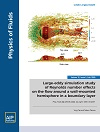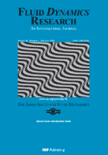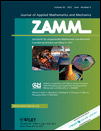
PHYSICS OF FLUIDS
Scope & Guideline
Innovating Insights in Fluid Physics
Introduction
Aims and Scopes
- Fluid Dynamics and Mechanics:
The core focus of the journal lies in the fundamental principles of fluid dynamics and mechanics, encompassing the study of flow behavior, turbulence, and the interaction of fluids with solid boundaries. - Multiphase and Complex Fluids:
Research on multiphase flows, including interactions between different fluid phases (gas, liquid, solid) and the effects of complex fluid properties, such as non-Newtonian behavior and viscoelasticity. - Computational Fluid Dynamics (CFD) Techniques:
Significant emphasis on the development and application of advanced computational techniques, including numerical simulations, lattice Boltzmann methods, and machine learning approaches for fluid dynamics problems. - Experimental Fluid Dynamics:
The journal highlights experimental studies that validate theoretical models and simulations, exploring real-world fluid phenomena in controlled environments. - Applications in Engineering and Environmental Sciences:
Research that addresses practical applications of fluid dynamics in engineering fields, including aerospace, biomedical, and environmental contexts, aiming to solve real-world challenges. - Interdisciplinary Approaches:
Encourages studies that bridge fluid dynamics with other scientific disciplines such as biology, materials science, and geophysics, enhancing the understanding of complex fluid interactions.
Trending and Emerging
- Machine Learning and Data-Driven Approaches:
An increasing number of studies are integrating machine learning techniques to enhance fluid dynamics modeling and simulations, demonstrating the potential for improved predictive capabilities and optimization. - Fluid-Structure Interaction:
Research exploring the interplay between fluid dynamics and structural mechanics is gaining traction, particularly in applications such as biomedical devices and aerospace engineering. - Thermal and Non-Newtonian Fluid Dynamics:
There is a growing interest in the dynamics of thermal fluids and non-Newtonian fluids, particularly in contexts involving energy transfer, phase changes, and complex rheological behaviors. - Environmental Fluid Dynamics:
Emerging themes focus on environmental applications, particularly in relation to climate change effects, fluid dynamics in natural systems, and pollution dispersion modeling. - Cavitation and Bubble Dynamics:
Research into cavitation phenomena and bubble dynamics is on the rise, driven by applications in various engineering fields, including propulsion and energy generation. - Active Flow Control Techniques:
Studies on active flow control methods, such as plasma actuators and synthetic jets, are trending, reflecting the need for enhanced performance in aerodynamic applications.
Declining or Waning
- Traditional Fluid Mechanics:
Research focusing solely on traditional fluid mechanics principles without integrating modern computational or experimental techniques has seen a downturn, as the field evolves towards more complex and interdisciplinary studies. - Static Fluid Studies:
Papers centered on static fluid behaviors, such as basic hydrostatics or simple laminar flows, are becoming less common as the community shifts towards dynamic, turbulent, and multiphase flow investigations. - Simplistic Modeling Approaches:
There is a noticeable decrease in the publication of studies employing overly simplistic models that do not account for the complexities of real fluid behavior, as the field increasingly values more sophisticated modeling techniques. - Single-Phase Flow Studies:
Research focusing exclusively on single-phase flows is diminishing, with a greater emphasis now placed on multiphase interactions and their complexities in various applications.
Similar Journals

Journal of Applied Mechanics and Technical Physics
Connecting Scholars to the Future of Applied PhysicsJournal of Applied Mechanics and Technical Physics is a distinguished publication that serves as a vital resource for researchers and professionals in the realms of mechanical engineering, mechanics of materials, and condensed matter physics. Published by MAIK NAUKA/INTERPERIODICA/SPRINGER, this journal has been committed to disseminating high-quality research since its inception in 1965. With a noted presence in the academic community, it holds a respectable Q3 ranking in multiple categories as of 2023, indicating its relevance and contribution to the field. Although it does not currently offer open access, the journal provides valuable insights and advancements through its rigorous peer-review process. Covering a broad spectrum of topics in applied mechanics and technical physics, it aims to foster innovation and dialogue among scientists, engineers, and scholars alike. Located in the United States, the journal continues to make significant strides in bridging the gap between theoretical research and practical applications, making it an essential read for anyone engaged in these dynamic fields.

International Journal of Fluid Mechanics Research
Elevating Scholarly Communication in Mechanical EngineeringThe International Journal of Fluid Mechanics Research, published by BEGELL HOUSE INC, is a pivotal platform for the dissemination of innovative research within the fields of Mechanical Engineering and Physics. With a focus on the intricate dynamics of fluid behavior, this journal has been a cornerstone of scholarly communication since its inception in 1996, continuing to engage a global audience of researchers and professionals through to 2024. With a respectable Impact Factor reflecting its significant contributions to the disciplines—ranking in Q3 for both Mechanical Engineering and Miscellaneous Physics and Astronomy categories—this journal presents a unique opportunity for authors to share their findings in a peer-reviewed environment. Although it does not currently offer Open Access options, all published articles are carefully curated, ensuring high-quality research is accessible to its readership. As the journal navigates the complexities of fluid mechanics, it fosters an interdisciplinary dialogue, bridging theoretical frameworks with practical applications, thereby enhancing understanding and innovation in related fields.

MECCANICA
Fostering Collaboration in Cutting-edge ResearchMECCANICA, an esteemed journal published by Springer, stands at the forefront of research in the fields of Condensed Matter Physics, Mechanical Engineering, and Mechanics of Materials. Established in 1966 and continuing through 2024, this journal provides a robust platform for the dissemination of innovative research and advancements in these increasingly interconnected domains. With an impressive 2023 ranking placing it in the Q2 category across multiple fields, MECCANICA boasts a Scopus rank of #198 in Mechanical Engineering, #150 in Condensed Matter Physics, and #141 in Mechanics of Materials, highlighting its significance and influence within the scholarly community. The journal aims to foster dialogue among researchers, professionals, and students, facilitating the exchange of cutting-edge ideas and methodologies crucial for overcoming contemporary engineering and physics challenges. Readers can access a wealth of knowledge through its comprehensive articles, and while it does not currently offer open access, the journal remains instrumental in shaping the future of engineering and physical sciences.

Fluids
Advancing fluid dynamics through open access research.Fluids is a leading open-access journal published by MDPI that commenced its publication in 2016, fostering a vibrant platform for the dissemination of high-quality research in the fields of Condensed Matter Physics, Fluid Flow and Transfer Processes, and Mechanical Engineering. Based in Switzerland, the journal has earned a prominent reputation, achieving a Q2 categorization in the latest 2023 rankings, indicating its significant impact within respective subject areas. Researchers and professionals will find Fluids an invaluable resource, as it not only facilitates the sharing of innovative studies but also provides open access to research findings, ensuring widespread visibility and utility. With a diversified editorial board and a commitment to exploration in fluid dynamics and related applications, Fluids aims to advance knowledge, foster collaboration, and inspire future research endeavors among its readership. As the journal converges into new frontiers from 2016 to 2024, it continues to be a pivotal reference for scholars and practitioners alike.

FLUID DYNAMICS RESEARCH
Bridging Disciplines through Fluid Dynamics ExplorationFLUID DYNAMICS RESEARCH, published by IOP Publishing Ltd, is a pivotal journal dedicated to advancing the understanding of fluid dynamics through interdisciplinary research that spans several domains including mechanical engineering and physics. With an ISSN of 0169-5983 and E-ISSN 1873-7005, this journal provides a vital platform for researchers aiming to disseminate new findings and theoretical advancements in fluid flow and transfer processes. As of 2023, FLUID DYNAMICS RESEARCH holds a commendable position within the academic community, ranked Q3 in fluid flow and transfer processes, mechanical engineering, and miscellaneous physics and astronomy categories. The journal showcases a diverse array of articles that not only inspire collaboration among professionals and students but also ensure that theoretical and experimental studies are accessible for further development in the field. Operating from the United Kingdom, the journal offers a unique opportunity for scholars worldwide to contribute to the vibrant community dedicated to understanding the complexities of fluid dynamics, even as it anticipates converging its years of research from 1986 to 2024.

Journal of the Serbian Society for Computational Mechanics
Bridging Theory and Application in MechanicsJournal of the Serbian Society for Computational Mechanics, published by the Serbian Society for Computational Mechanics, is a vital platform for advancing research and knowledge in the field of computational mechanics. Established in 2012, this journal serves the academic community by providing a forum for innovative studies, methodologies, and applications within computational mechanics, presenting valuable insights for researchers, professionals, and students alike. With an ISSN of 1820-6530 and a ranking of Q4 in Computational Mechanics, it carries an essential influence in the engineering realm, despite its current rank of 71 out of 89. The journal's commitment to scholarly excellence aims to foster collaboration and encourage interdisciplinary research, making it an important resource for those invested in the evolving landscape of computational methodologies. Although the journal currently does not offer Open Access options, it remains dedicated to disseminating knowledge that will resonate within the local and global scientific community.

PROGRESS IN COMPUTATIONAL FLUID DYNAMICS
Pioneering Insights into Computational Fluid DynamicsPROGRESS IN COMPUTATIONAL FLUID DYNAMICS, published by InderScience Enterprises Ltd, is a vital journal in the realms of Computer Science Applications and Condensed Matter Physics. Established in 2001, this journal serves as a platform for disseminating innovative research findings and technological advancements in computational fluid dynamics, targeting both theoretical and applied aspects. With a current impact factor positioning it in the Q4 quartile for its fields, it captures a wide array of topics including numerical methods, simulation techniques, and real-world fluid dynamics applications, fostering dialogue among researchers, practitioners, and educators alike. Although it does not provide Open Access options, it remains an important resource for those investigating fluid dynamics phenomena. As it continues to evolve through 2024, PROGRESS IN COMPUTATIONAL FLUID DYNAMICS is positioned to contribute significantly to the scientific community, addressing core challenges while promoting collaboration and knowledge exchange.

ZAMM-Zeitschrift fur Angewandte Mathematik und Mechanik
Advancing the Frontiers of Applied Mathematics and Mechanics.ZAMM-Zeitschrift fur Angewandte Mathematik und Mechanik is a distinguished journal published by WILEY-V C H VERLAG GMBH, committed to advancing the fields of applied mathematics and computational mechanics since its inception in 1921. With a significant trajectory spanning nearly a century, this journal serves as a critical platform for the dissemination of high-quality, peer-reviewed research that encompasses theoretical and practical advancements in these disciplines. Currently holding a Q3 category in Applied Mathematics and Q2 in Computational Mechanics as per the 2023 rankings, ZAMM demonstrates its prominence with measurable impact in both fields, reflected in its Scopus rankings: 202 out of 635 journals in Applied Mathematics and 32 out of 89 in Computational Mechanics. Although it does not provide open access, ZAMM remains invaluable to researchers, professionals, and students seeking to deepen their understanding and contribute to the evolving landscape of mathematical applications in engineering contexts. Explore the latest insights and methodologies that push the boundaries of applied mathematics and mechanics by engaging with ZAMM’s comprehensive range of articles.

Physical Review Fluids
Exploring the Depths of Fluid DynamicsPhysical Review Fluids is an esteemed journal published by the American Physical Society, focusing on the intricate and essential field of fluid dynamics. With an impressive Q1 ranking in categories such as Computational Mechanics, Fluid Flow and Transfer Processes, and Modeling and Simulation, this journal serves as a pivotal resource for researchers and professionals seeking to disseminate high-quality and innovative research findings. The journal's scope encompasses a broad spectrum of topics within fluid mechanics, promoting advancements in theoretical, computational, and experimental methodologies. Although it is not an open-access journal, its publications are critically well-received, underpinned by its strong standing in the Scopus rankings which place it in the top percentiles across various relevant fields. Physical Review Fluids has been a foundational platform for scholars to share their discoveries from 2016 through 2024, making it an indispensable asset in the ongoing evolution of fluid dynamics research.

Computational Particle Mechanics
Innovating Through Particle-Based SimulationsComputational Particle Mechanics, published by SPRINGER INTERNATIONAL PUBLISHING AG, is a leading journal dedicated to advancing knowledge in the interdisciplinary fields of computational mechanics, civil engineering, and fluid dynamics. With an impressive impact factor reflecting its high-quality research publications, this journal maintains a strong presence in the academic community with a Q1 ranking in categories such as Civil and Structural Engineering, Computational Mechanics, and Numerical Analysis as per the latest 2023 evaluations. Researchers and professionals benefit from the journal's commitment to open-access options, promoting wider dissemination of groundbreaking studies. Operating under the Swiss publishing house since 2014, Computational Particle Mechanics aims to foster innovation through the exploration of particle-based methods and simulations, making significant contributions to methodologies within computational mathematics and modeling. As the journal continues to evolve until its converged years end in 2024, it stands as a vital resource for those looking to enhance their expertise in dynamic modeling and simulation techniques.